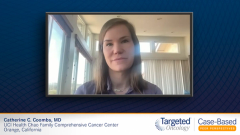
Patient Profile: A 70-Year-Old Man with Relapsed/Refractory CLL
Catherine C. Coombs, MD, presents the case of a 70-year-old man with relapsed/refractory chronic lymphocytic leukemia and offers her initial impressions.
Episodes in this series

Case: A 70-Year-Old Man with R/R Chronic Lymphocytic Leukemia (CLL)
- Patient AL is a 70 y/o man.
- PMH: T2DM and Hypertension (both well controlled with medication)
- SMH: Does not smoke or drink alcohol.
Clinical Presentation:
- In July 2022, AL was diagnosed with CLL and had been previously treated with venetoclax plus obinutuzumab upon initial diagnosis. Less than 6 months later, AL presented to his oncologist reporting an unresolved fever and increased fatigue.
Clinical Workup and Molecular Testing:
- Laboratory Findings:
- WBC: 120,000
- Hgb, 9.1 g/dL
- Platelets, 92 x 109/L
- Molecular Testing:
- Elevated serum beta-2-microglobulin
- Flow cytometry, CD5+, CD19+, CD23+
- IGHV/TP53 mutational status: unmutated
- FISH detect del(17p)
- ECOG PS 1
Disease Relapse and Treatment(s):
- Further disease progression was documented, and a joint decision was made to initiate AL on venetoclax plus rituximab.
- Venetoclax Dosing Ramp-Up Schedule
- Starting dose of 20 mg PO QD x 7 days, then weekly ramp up to 50 mg, 100 mg, 200 mg, and 400 mg PO daily. The recommended daily dose (400 mg) continues from week 5 and beyond for 24 months.
- Rituximab 375 mg/m2 on C1D1 (28-day cycle), then 500 mg/m2 on Day 1 for 5 cycles (completing after month 6).
- Venetoclax Dosing Ramp-Up Schedule
Transcript:
Catherine Coombs, MD: Hi, this is a Targeted Oncology™ Case-Based Peer Perspectives [program]. [I’ll be discussing] a 70-year-old man with relapsed/refractory chronic lymphocytic leukemia [CLL]. I’m Dr Catherine Coombs at the University of California, Irvine, where I’m an associate clinical professor.
Our clinical case is a 70-year-old man with CLL. His medical history includes type 2 diabetes and hypertension, which are well controlled on medications. He does not smoke or drink alcohol. Regarding his clinical history, in July 2022 he was diagnosed with CLL and had previously been treated with venetoclax and obinutuzumab upon initial diagnosis. However, less than 6 months following completion of therapy, he presented to his oncologist reporting an unresolved fever and increased fatigue. His clinical work-up and molecular testing showed a white blood cell count of 120,000 per mm3, a hemoglobin count of 9.1 g/dL, and a platelet count of 92,000 per mm3. The molecular tests show that his IGHV was unmutated, and he had an unmutated TP53 mutation testing. However, his FISH [fluorescence in situ hybridization] testing revealed a deletion 17p.
Additional tests showed that he had an elevated serum beta-2-microglobulin. His flow [cytometry] was consistent with CLL in that it was positive for CD5, CD19, and CD23. He had a fairly good performance status, ECOG 1. After discussion with his oncologist and upon confirming disease progression, a joint decision was made to initiate him on the venetoclax-rituximab regimen. Venetoclax was introduced at the standard 5-week ramp-up: the patient started on 20 mg and then went to 50, 100, 200, and 400 mg daily. The intention is to continue the 400-mg dose from week 5 and beyond for 24 months. The rituximab was utilized in the standard fashion based on the MURANO trial, where he was given 375 mg/m2 on cycle 1, day 1 and the subsequent cycles 2 through 6 were at the 500-mg/m2 dose.
My initial thought is that this is a pretty unusual case. We have a 5-year follow-up of the venetoclax-obinutuzumab regimen, and the median progression-free survival [PFS] has still not been reached. For someone to progress 6 months following the completion of therapy, this is far from what we’d expect; it’s a lot earlier. I’d want to make sure nothing unusual is going on. I’d worry about if this could be a Richter transformation or if these fevers could represent infection or something else. His labs are consistent with relapsed CLL, so I presume that we had excluded a Richter transformation. This patient had a very poor response to venetoclax, much shorter than what would be expected for most patients.
He has deletion 17p, and patients with deletion 17p are among those with the shortest remissions following venetoclax-obinutuzumab. But of the 20 or so patients from the initial CLL14 trial, their median PFS was around 4 years. For this patient, it’s much shorter than that, so his prognosis isn’t very good. However, we have a lot of options. In this case he was re-treated with venetoclax. I may have selected something different if I were seeing him, given that he had such a poor response to his initial venetoclax course. He might be able to reach some degree of remission with this given that he responded, but I’d be very reluctant to stop at the planned 2-year mark given that he relapsed 6 months after completing the 1-year therapy that was selected as his first-line therapy. Instead of re-treatment with venetoclax in this exceptionally short responder, I might have considered a different type of continuous therapy, namely a BTK [Bruton tyrosine kinase] inhibitor. I’d consider using second-generation BTK inhibitors like acalabrutinib and zanubrutinib continuously, which might afford him a longer time until progression.
Transcript edited for clarity.






































